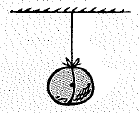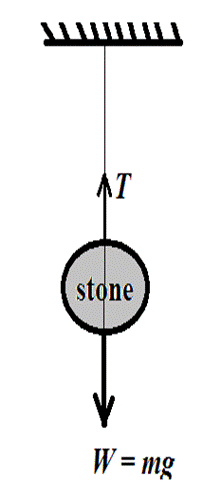
Concept explainers
Here a stone is suspended at rest by a string.
a. Draw force vectors for all the forces that act on the stone,
b. Should your vectors have a zero resultant?
c. Why, or why not?

(a)
To Sketch: The force vectors for the forces acting on the stone.
Explanation of Solution
Consider a stone is suspended by a string.
Consider the mass of the stone is denoted by
Consider the acceleration due to gravity of the Earth is denoted by
The gravitation force of the Earth applies a gravitational pull on the suspended stone.
For the stone to be in rest, the tension
Show the forces acting on the stone as shown in the Figure below:

Refer the Figure.
The stone’s weight
The tension
Hence, the sketch for the force vectors for the forces acting on the stone is shown.
Conclusion:
Thus, the sketch for the force vectors for the forces acting on the stone is shown.
(b)
Whether the force vectors should have zero resultant.
Answer to Problem 47A
The force vectors (stone weight and tension in the string) should have zero resultant.
Explanation of Solution
Refer Part (a).
The weight
The tension
For the stone in rest condition, the weight of the stone equals the tension in the string.
Conclusion:
Thus, the force vectors (stone weight and tension in the string) should have zero resultant.
(c)
The reason whether the force vectors should have zero resultant or not.
Answer to Problem 47A
The force vectors (stone weight and tension in the string) should have zero resultant as the stone is in rest condition.
Explanation of Solution
Refer Part (a) and Part (b).
The weight
The tension
For the stone in rest condition, the weight of the stone equals the tension in the string.
The resultant vector for these equal and opposite forces is zero.
Conclusion:
Thus, the force vectors (stone weight and tension in the string) should have zero resultant as the stone is in rest condition.
Chapter 3 Solutions
EP CONCEPTUAL PHYSICS-ITEXT ACCESS
Additional Science Textbook Solutions
Anatomy & Physiology (6th Edition)
Campbell Biology in Focus (2nd Edition)
Human Physiology: An Integrated Approach (8th Edition)
Microbiology: An Introduction
Applications and Investigations in Earth Science (9th Edition)
Physics for Scientists and Engineers: A Strategic Approach, Vol. 1 (Chs 1-21) (4th Edition)
- help me with the experimental set up for the excel i did. the grapharrow_forwardWhich of the following best describes how to calculate the average acceleration of any object? Average acceleration is always halfway between the initial acceleration of an object and its final acceleration. Average acceleration is always equal to the change in velocity of an object divided by the time interval. Average acceleration is always equal to the displacement of an object divided by the time interval. Average acceleration is always equal to the change in speed of an object divided by the time interval.arrow_forwardThe figure shows the velocity versus time graph for a car driving on a straight road. Which of the following best describes the acceleration of the car? v (m/s) t(s) The acceleration of the car is negative and decreasing. The acceleration of the car is constant. The acceleration of the car is positive and increasing. The acceleration of the car is positive and decreasing. The acceleration of the car is negative and increasing.arrow_forward
- Which figure could represent the velocity versus time graph of a motorcycle whose speed is increasing? v (m/s) v (m/s) t(s) t(s)arrow_forwardUnlike speed, velocity is a the statement? Poisition. Direction. Vector. Scalar. quantity. Which one of the following completesarrow_forwardNo chatgpt pls will upvote Already got wrong chatgpt answerarrow_forward
- 3.63 • Leaping the River II. A physics professor did daredevil stunts in his spare time. His last stunt was an attempt to jump across a river on a motorcycle (Fig. P3.63). The takeoff ramp was inclined at 53.0°, the river was 40.0 m wide, and the far bank was 15.0 m lower than the top of the ramp. The river itself was 100 m below the ramp. Ignore air resistance. (a) What should his speed have been at the top of the ramp to have just made it to the edge of the far bank? (b) If his speed was only half the value found in part (a), where did he land? Figure P3.63 53.0° 100 m 40.0 m→ 15.0 marrow_forwardPlease solve and answer the question correctly please. Thank you!!arrow_forwardYou throw a small rock straight up from the edge of a highway bridge that crosses a river. The rock passes you on its way down, 5.00 s after it was thrown. What is the speed of the rock just before it reaches the water 25.0 m below the point where the rock left your hand? Ignore air resistance.arrow_forward
 College PhysicsPhysicsISBN:9781305952300Author:Raymond A. Serway, Chris VuillePublisher:Cengage Learning
College PhysicsPhysicsISBN:9781305952300Author:Raymond A. Serway, Chris VuillePublisher:Cengage Learning University Physics (14th Edition)PhysicsISBN:9780133969290Author:Hugh D. Young, Roger A. FreedmanPublisher:PEARSON
University Physics (14th Edition)PhysicsISBN:9780133969290Author:Hugh D. Young, Roger A. FreedmanPublisher:PEARSON Introduction To Quantum MechanicsPhysicsISBN:9781107189638Author:Griffiths, David J., Schroeter, Darrell F.Publisher:Cambridge University Press
Introduction To Quantum MechanicsPhysicsISBN:9781107189638Author:Griffiths, David J., Schroeter, Darrell F.Publisher:Cambridge University Press Physics for Scientists and EngineersPhysicsISBN:9781337553278Author:Raymond A. Serway, John W. JewettPublisher:Cengage Learning
Physics for Scientists and EngineersPhysicsISBN:9781337553278Author:Raymond A. Serway, John W. JewettPublisher:Cengage Learning Lecture- Tutorials for Introductory AstronomyPhysicsISBN:9780321820464Author:Edward E. Prather, Tim P. Slater, Jeff P. Adams, Gina BrissendenPublisher:Addison-Wesley
Lecture- Tutorials for Introductory AstronomyPhysicsISBN:9780321820464Author:Edward E. Prather, Tim P. Slater, Jeff P. Adams, Gina BrissendenPublisher:Addison-Wesley College Physics: A Strategic Approach (4th Editio...PhysicsISBN:9780134609034Author:Randall D. Knight (Professor Emeritus), Brian Jones, Stuart FieldPublisher:PEARSON
College Physics: A Strategic Approach (4th Editio...PhysicsISBN:9780134609034Author:Randall D. Knight (Professor Emeritus), Brian Jones, Stuart FieldPublisher:PEARSON





